This week, Chris and Steve talk about Monogatari‘s long-lasting appeal—and see how far they can go before mentioning the infamous toothbrushing scene.
Disclaimer: The views and opinions expressed by the participants in this chatlog are not the views of Anime News Network.
Spoiler Warning for discussion of the series ahead. Bakemonogatari, Nisemonogatari, Monogatari Series Second Season, and MONOGATARI Series: OFF & MONSTER Season are all streaming on Crunchyroll.
Kizumonogatari is available to rent on Amazon Prime.
Chris
Steve, it’s time for TWIA to fulfill our mandated minimum of educational content. Lucas and Nick just taught people about the world-uniting culture of the Olympic Games, so I figured we could go for a subject a bit more practical and closer to home.
Dental hygiene.
Steve
That’s right, folks. There’s nothing funny about gingivitis.

Now be sure to brush them at least twice a day. And if you need assistance, you can always count on family.
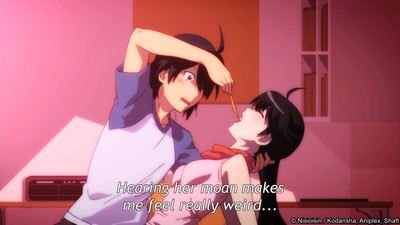
Never say anime never taught you anything, especially when its source material is acclaimed literature. The esteemed
Monogatari series is based on a long-running line of
books, it must be educational!
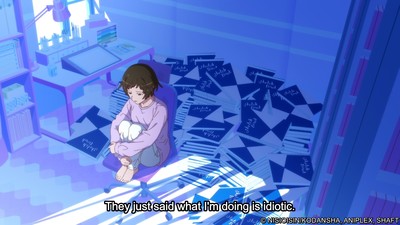
It’s simple: I see a block of words flash for 30 milliseconds on the screen, and I know I’m enjoying a pillar of the literary canon.

Sometimes you don’t even need real text.

All joking aside, it’s a good time to be a
Monogatari fan, however (justifiably) maligned we may be. We’ve got a compilation film coming stateside later this month, we’ve got a new season streaming weekly for the first time in half an age, and Araragi has been safely quarantined from most of the cast. It’s enough to make you beam with joy.

Cut Arararagi out and replaced him with a bunch of extra Nadekos, in what I’d say is a pretty fair trade.

Honestly, much as I’m enjoying the new, naturally absurdly titled
OFF & MONSTER Season, I am surprised we wound up here.
Monogatari has “ended” at least two times before this, and the increasingly esoteric
franchise is over fifteen years old at this point. That’s longer than a ton of modern anime viewers have been alive! I wonder what uninitiated viewers think if they idly tune into this mess of meandering dialogues with like a hundred episodes of build-up that came before.

In many ways, it feels like a relic of a bygone era—a good era, mind you, because it was my era. Way back before our complaints about light novel anime morphed into complaints about isekai anime. Back when you could sell an obnoxiously verbose show on the strength of how nude its female cast tended to be. Bakemonogatari became a certified phenomenon in 2009, and I still don’t fully understand how that happened.
In retrospect, it’s very strange to think about. I was still being somewhat selective about what seasonals I kept up on back in that era, but I naturally picked up on people chattering about this odd little
MonSTory show. Like you said, light novel anime were firmly all the rage back then, knee-deep as we were in
Haruhis and
Spice and Wolfs. What
Bakemonogatari had besides its walls of text was its extremely recognizable stylistic approach that served as many viewers’ first introduction to the proclivities of one
Akiyuki Simbo.

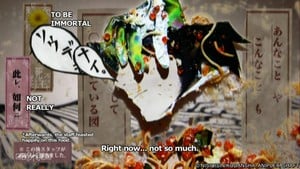


Not mine, though. I’d seen
Moon Phase and
Negima!
It was
Sayonara, Zetsubou-Sensei for me. Shaft’s house style under the direction of Simbo was definitely a known quantity at that point, but with
Bakemonogatari specifically, I feel like
Tatsuya Oishi took things to stylish new pop art excess. The colors, the mixed media, the tempo of the editing, the fusion of perversion and poignancy—
Bakemonogatari had oomph. And oofs. But mostly oomph.



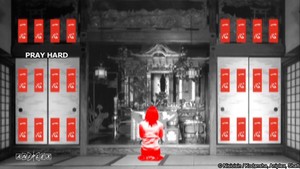
I’d also wager the music was a big factor in its popularity. That first slate of character OPs was pretty incredible, and the ED remains an all-timer.
It was just the other week I was reminiscing with Nick about the sheer number of remixes that “Renai Circulation” got, and yeah, “Kimi no Shiranai
Monogatari” still hits me just right. And that’s not even getting into the in-show score. I had “Ika Kaisou” on my regular listening rotation for a while there.
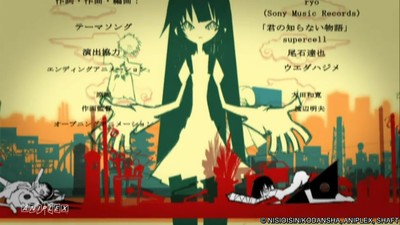
It’s all a potent presentation that uplifts a series that, as you said, might not be primed for mainstream success. I didn’t know much about
Bakemonogatari going into it. Within those first couple of episodes, I’d clocked it as a series that was mostly going to be driven by characters hanging around having long-winded conversations.
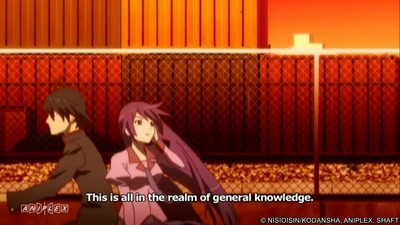
Nisio Isin can and does love writing the hell out of character dialogue.
That he does! At the time, I think this was the most friction I’d run into between my one year of formal Japanese education and the myriad of puns, cultural touchstones, and
words the show threw at you. But between the aesthetic wizardry and the strength of the characters,
Bakemonogatari hooked me early on too. Like, it’s easy to take for granted now, but imagine if this got a no-frills adaptation filled with nothing but shot/reverse shot scenes of talking heads. It would’ve been cooked from the start.

It’s one to look back on (and currently on, I guess) compared to the number of light novel adaptations we do get like that. Pour one out for
My Stepmom’s Daughter Is My Ex, oh but that you had one-tenth of this sauce.

To be fair, I’ve definitely enjoyed my share of comparatively bland adaptations of similarly dialogue-heavy novels about supernatural mysteries (hello,
In/Spectre). But those haven’t had anywhere near the cultural saturation that
Monogatari has enjoyed. The lesson: you gotta get weird with it.

For better or for worse.


We already covered this when we did our “problematic faves” column, but I must reluctantly go on record as an Araragi defender. However despicable his depths may be, he’s several cuts above your average light novel protagonist. I mean, for one, he has a personality. And for two, his girlfriend chains him to a chair when he acts up. That’s a good start.

You know, as I’ve gotten older, I’ve grown to respect the presence of bits more. I think it also helps that the narrative is heavily and increasingly invested in dunking on Arararararagi’s flaws, both in jokey and serious ways. And lest I let that
Mushoku Tensei comment pass, however tongue-in-cheek it might have been, the comparison disintegrates when you compare the female casts in both series.
Monogatari legit has maybe my favorite collection of women in the animesphere? They’re all so inspiring.

It’s debatable whether
Monogatari is or ever was a “harem” series. Regardless, this group of girls stands out from other gaggles due to how fully formed they emerge, and then keep on going. Sure, they’ve all got their own reliably repeated defining character tics. Say the line, Hanekawa:

But even though the narratives ostensibly start with Araragi at the nexus of solving these girl problems,
Monogatari‘s writing, pretty much from the beginning, is solidly insistent about them ultimately being the ones to save themselves. That kind of forward character motion propels them to further progress after their introductory arcs are up.
That’s why, as much as I like
Bakemonogatari, I think it ends up being the weakest collection of stories due to its focus on simpler introductory arcs. The true joy of this
franchise lies in all of the character developments and interactions beyond that. And that’s why
Nisemonogatari is where the series starts fulfilling its potential. The toothbrush incest is merely incidental. You find the real meat in the long stretches of dialogue that peel back more of these characters’ souls. And, of course, you find even better meat in Kaiki.
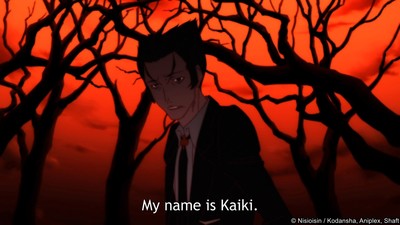
Oh, I’m sure we could talk about Kaiki’s meat all day.

This man has done nothing wrong, ever, in his life, and I love him.
I didn’t have enough time to go back and rewatch the full series for this column, but I definitely made the time to rewatch
Koimonogatari, a.k.a
Kaikimonogatari. I love this curmudgeon conman so much. He’s the best narrator in an all-star lineup of
Monogatari narrators. And the sexiest.




Hitagi End was at the top of my refresher pile as well. It’s funny, I can definitely discuss how
Monogatari‘s progress can be measured in its willingness to let its ladies lead stories on their own, untethered from Araragi. But it’s actually outstanding that the truly superlative replacement for Araragi is an even slimier, technically
worse dude.

I say this all with maximum respect for the King of The Hustle.
His layers bring out and interface with the layers of
other characters, as is so wont to happen in this series, but seemingly more so with Kaiki. Both Gaen and Senjyogahara try to drive him to drop out of solving the Case of the Godly Nadeko (long story). But they’re only doing so because they know it’ll make him stay in harder, and he
knows that’s why they’re doing it, and they
know that he
knows. Talk about mobius strips.


To be sure, that philosophy of his about “The fake being more real” is something I’ve turned over in my head since the very first time I watched
Nisemonogatari.
Honestly, so much of the series has stuck with me in the past decade and a half. And not just within the confines of the animation. Back when Kizumonogatari had its limited theatrical runs, I made three trips up to NYC to see each part. I met up with some online friends, we got to see the films in a big historic theater, and we hung out for food and karaoke afterward. Those are great memories.
A series that’s been around and has been a part of the weeb community this long has certainly touched a lot of people. I never got out to see the
Kizumonogatari films when they were in theaters, myself, so it’s cool to know that I’ll be able to get another chance, after a fashion, with those films’ compilation film.
I could even bring some friends with me, unfamiliar as they may be. It’s technically a prequel, it’s certainly way easier to follow than any of the latter-day Monogatari material that’s continued to expand on this world of oddities.
True. As much as I recommend that people watch
Bake first (always prioritize release order over chronological order),
Kizu is at least sorta standalone.
OFF & MONSTER Season requires homework.


It does at least have those priorities right when it comes to that watch order, though.

But yeah, perhaps as a consequence of years of filled-in material, as well as being billed as something of a comeback for a
franchise that was last seen almost five years ago,
OFF & MONSTER Season feels like quite the referential celebration of all the
Monogatari that came before. The current story arc is all about that girl from the
Renai Circulation meme song interacting with versions of herself in all her previous outfits, for Mayoi’s sake!

It’s cool because the plot works as a showcase of the ongoing strengths of
Monogatari we’ve mentioned so far: the manifold interiority its characters have, and their ability to lead stories independent of Araragi’s interactions.


Also important: its ability to get the characters into cute new outfits.
In Nisio Isin land, it’s not true character development unless a person changes their wardrobe and/or haircut at least once.

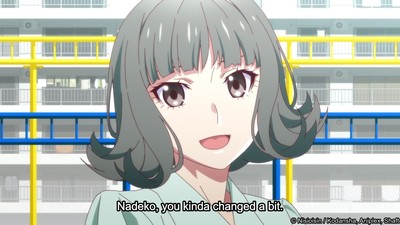
Hey, that even goes for Araragi (eventually).

God the dude’s
Hanamonogatari design remains one of the most objectively funny time-skip designs in an anime
franchise.
Speaking of
Hanamonogatari, gender is also fairly flexible.


As an overarching character who explicitly fucks with the other characters, the gender binary, and that concept of chronological order, I can’t not love Ougi.


I always thought
Hanamonogatari ruled by virtue of being “The Kanbaru Movie”. But it also was one of the stories that pre-proved
OFF & MONSTER Season‘s current appeal, alongside
Nekomonogatari (White) and the aforementioned
Koimonogatari by demonstrating how the
franchise could work while (mostly) lacking Araragi. Truly, it always has been an ensemble piece.

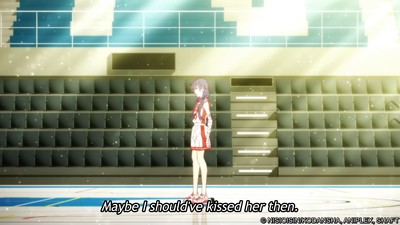
I mean, I get why people might be inclined to get hung up on Araragi’s indecent jokes about, say, Hachikuji’s underwear. But I’d vehemently argue that
Monogatari‘s rich cast of complicated and ever-evolving women puts it in even rarer and more valuable company. I could write an essay about each of them and their journey so far.

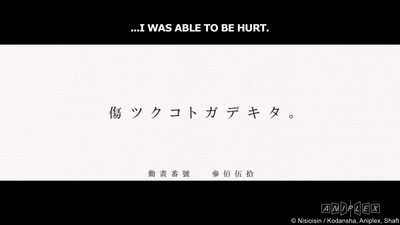
The series wouldn’t have stuck around for the long haul it has, I think, if its characters didn’t have that capacity. The final TV-aired episode of the original
Bakemonogatari is a half-hour of characters talking in a car and then lying out in a field, and it remains one of the most arresting single episodes of television I’ve seen because of what it embodies
about those characters. Ironically, Senjyogahara’s point that she has so little to offer here belies the ultimate depths that she and the rest of the cast will go on to display.

Further ironically, the episodes that come right after this one and follow Hanekawa on what will eventually be her own tiger-striped trip still can’t be officially streamed in English. Thanks,
Aniplex.
Ah, it wouldn’t be an Aniplex production if it weren’t both inconsistently available and prohibitively expensive to own. You could, at one point, stream the end of Bake and Koyomimonogatari on Funimation, but not anymore. Zoku Owari is also something you gotta buy the Blu-rays to watch—if you can shell out about 350 bucks to do so. It sucks. While I do own some of the series on physical media, it’d be nice to afford it all.
Nekomonogatari (Black) is also MIA, indicating that the streaming sphere really has it out for Hanekawa, for some reason.
That’s to say nothing of how dang crusty the version of Bakemonogatari streaming on Crunchyroll looks.

Come on, the visuals are a huge part of this show’s identity! You gotta preserve them better than this!
Maybe one day,
Aniplex will realize U.S. customers aren’t buying 2 anime episodes on VHS for 50 dollars anymore. Maybe. On the upside, though,
Vertical‘s been good about bringing the novels over, glossy boxsets and all. I’ve been thinking, instead of rewatching the anime, I might hunker down and read the series instead, and I appreciate having the option. Even though I inevitably picture and hear the anime portrayals in my head when I do so.

I’ve got a few physical copies of the novels myself, alongside a whole bunch of e-books I scored in a HumbleBundle years ago. That also came with a volume of the manga adaptation, and if you thought the TV series was fanservicey, know that this iteration is illustrated by
Oh! great!

So even without
OFF & MONSTER Season and the compilation movie coming soon, it is nice to know that I’d be hard up for running out of
Monogatari material even after all these years.
Same. But that being said, the arrival of the new season has definitely reignited my passion for the series. I’d let it simmer after
Kizu and
Owari finished, and now it’s back to a full boil. It feels like, visually and narratively, it hasn’t slowed down one bit. I keep waiting for Nisio Isin to sell out, but he seems committed to inventing compelling trials and tribulations for these characters to overcome. The bastard.
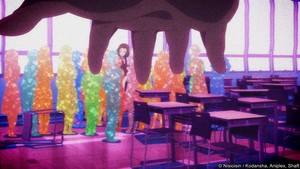



I’d say I’m largely in the same place as you, and this self-inflicted assignment of flashing back to the
franchise‘s earlier days definitely didn’t damper me making my way back into
Monogatari. I’ll probably keep coming back as long as Isin keeps writing these GhoSTories, and
SHAFT keeps animating them—and not for nothing, but we didn’t even get a chance to talk about how Simbo handing the directorial reins over to
Midori Yoshizawa for
OFF & MONSTER Season has reinvigorated the feel of the anime after this long. So I think there’s plenty of life in this animated corpse yet.

I’d say we’re in good hands. Maybe even hands I’d trust to brush my teeth for me.

Don’t forget those back molars! You gotta really shove that thing in there.






































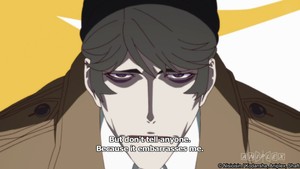

































![For the Fans[ervice] - This Week in Anime](https://theanimenews.net/wp-content/uploads/2024/11/1732205217_For-the-Fanservice-This-Week-in-Anime-390x220.webp)
